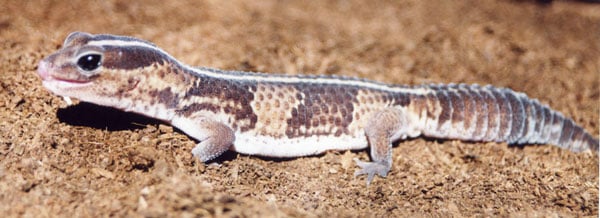Description:
Captive Housing Housing fat-tailed geckos is easy. Start with at least a 10-gallon terrarium or larger, depending on the number of geckos being housed. A 10-gallon tank will easily house one male and two females. A 20-gallon long tank can house one male and up to five females. Never house males together, as they are very territorial and tend to damage each other. Use coconut fiber for substrate. Provide a water bowl large enough for the geckos to get their heads in to drink, and give them two hides. Put one hide on the cool end and one on the hot end of the tank. More hides can be provided if desired, along with real or plastic plants or other décor. Each hide box should be large enough to hold all the geckos in the tank. Given that fat-tailed geckos require some humidity, place damp moss or a similar material in each hide box to help keep the geckos hydrated. These “humidity chambers” help the geckos when shedding and also help to keep them cool when they need it. Place a heat pad at the bottom of one end of the tank for heat. The ambient temperature should be about 80 degrees with a hotspot of around 90 degrees. No additional lighting is required besides what’s in the room normally, because these geckos are nocturnal. Spray the tank every few days to maintain a humidity of about 40 to 50 percent. Replace the moss or other bedding in the hide boxes once a week with new damp material to avoid mold buildup or as needed to keep the hides moist. Diet Fat-tailed geckos are insectivores. They will feed on crickets, mealworms, waxworms, Phoenix worms, silkworms and even small pinky mice. Feed them three times a week, as much as they will eat in one sitting. Dust the feeder insects with a calcium and multivitamin supplement every other feeding to ensure proper bone growth and D3 intake. What’s Available Fat-tailed geckos are being bred in increasing numbers now. You can still get fresh imports at a rather low price, but these usually arrive with regrown tails and can be rough-looking and a little beat up. There are two standard wild morphs, one being banded and the other with a single white stripe running down its back. There are many exciting morphs bred in captivity now, the most common produced being “jungle,” with a pattern where the band on the body and tail are broken. It also comes in a striped version. There are amelanistic fat-tails with colors ranging from peach, orange, tangerine and red with gray or white backgrounds. Those, also, come in the striped pattern. Other new morphs include: aberrant, patternless, white outs and white sox. More new colors and morphs are bound to pop up in the very near future, making fat-tailed geckos one of the most versatile color morphs of just about any gecko, second only to the leopard gecko.
Habitat:
Semi-arid to lush areas with lots of cover. During the day they can be found under rocks, in cracks and in between rocks; at night they can be spotted moving out in the open.
Range:
West Africa, from Senegal to Cameroon.
Scientific Name: Hemitheconyx caudicinctus
Species Group: gecko
Family: Gekkonidae
Size: N/A
Level: beginner
Weight: N/A
Dangerous: No


